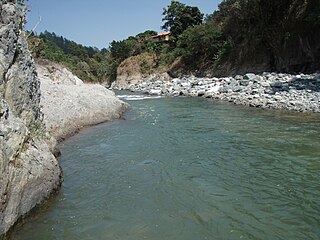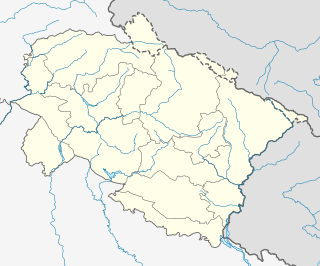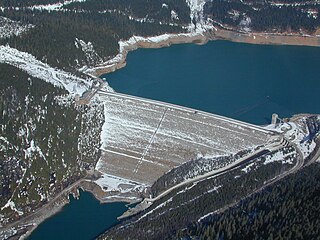
The Nurek Dam is an Earth-fill embankment dam on the Vakhsh River in Tajikistan. Its primary purpose is hydroelectric power generation and its power station has an installed capacity of 3,015 MW. Construction of the dam began in 1961 and the power station's first generator was commissioned in 1972. The last generator was commissioned in 1979 and the entire project was completed in 1980 when Tajikistan was still a republic within the Soviet Union, becoming the tallest dam in the world at the time. At 300 m (984 ft), it is currently the second tallest man-made dam in the world, after being surpassed by Jinping-I Dam in 2013. The Rogun Dam, also along the Vakhsh in Tajikistan, may exceed it in size when completed.

The Gandhi Sagar Dam is one of the four major dams built on India's Chambal River. The dam is located in the Mandsaur, Neemuch districts of the state of Madhya Pradesh. It is a masonry gravity dam, standing 62.17 metres (204.0 ft) high, with a gross storage capacity of 7.322 billion cubic metres from a catchment area of 22,584 km2 (8,720 sq mi). The dam's foundation stone was laid by Prime Minister of India Pandit Jawaharlal Nehru on 7 March 1954, and construction of the main dam was done by leading contractor Dwarka Das Agrawal & Associates and was completed in 1960. Additional dam structures were completed downstream in the 1970s.

The Yaque Del Norte River is the longest river in the Dominican Republic. The river rises in the centre of the country to the south of Santiago city in Santiago province. The river runs roughly due north, through Santiago, before turning west-north-west through the Cibao Valley. The river's source originates in the Cordillera Central as small rivulets, before merging into one as they flow north down toward the Cibao Valley. It enters the Manzanillo Bay in the Atlantic just west of Monte Cristi. The river is 298 km long, is the drainage basin for the north-west of the country and is economically important as a source of irrigation for rice-farming and other agriculture.

The Hàm Thuận – Đa Mi Hydroelectric Power Complex is a cascade of two hydroelectric power stations in Hàm Thuận Bắc District of the central region of Vietnam. It is operated by Da Nhim – Ham Thuan – Da Mi Hydropower Joint Stock Co., a subsidiary of Vietnam Electricity. The same company also operates the older Đa Nhim Hydroelectric Power Station.

The Ingula Pumped Storage Scheme is a pumped-storage power station in the escarpment of the Little Drakensberg range straddling the border of the KwaZulu-Natal and Free State provinces, South Africa. It is about 22 km (14 mi) North-East of Van Reenen. The pumped-storage hydroelectric scheme consists of an upper and a lower dam 4.6 kilometres (2.9 mi) apart and connected to a power station by tunnels. It was constructed by an Eskom and CMC Impregilo Mavundla Joint Venture The scheme was built at a cost of US$3.5 billion. Construction began in 2005 and the power station was scheduled to begin operations in late 2015, but the first two generators were not commissioned until March 2016, the third was brought into commercial operation in August 2016, and the fourth and final one in January 2017.

The Mingachevir Dam is the largest hydroelectric power station in the South Caucasus, is located over Kur river and not far from Mingachevir city.

Pantabangan Dam is an earth-fill embankment dam on the Pampanga River located in Pantabangan in Nueva Ecija province of the Philippines. The multi-purpose dam provides water for irrigation and hydroelectric power generation while its reservoir, Pantabangan Lake, affords flood control. The reservoir is considered one of the largest in Southeast Asia and also one of the cleanest in the Philippines. Construction on the dam began in 1971 and it was completed in 1974.

The Wanjiazhai Dam is a gravity dam on the Yellow River on the border of Pianguan County, Shaanxi Province and Inner Mongolia Autonomous Region, China. The main purpose of the dam is water supply for the Wanjiazhai Water Control Project along with peak hydroelectric power generation. Construction on the dam began in 1994, the first generator went online in 1998 and the last in 2000.

The Aguamilpa Dam is an embankment dam on the Río Grande de Santiago in the Mexican state of Nayarit, 38 km (24 mi) northeast of Tepic. The primary purpose of the dam is hydroelectric power generation and it supplies a 960 MW power station with water. Construction on the dam began in 1989 and it was completed in 1993 while the power station became operational in 1994.

La Yesca Dam is an embankment dam on the Santiago River 90 km (56 mi) northwest of Guadalajara on the border of Mexico's Nayarit and Jalisco states. Construction on the dam began in 2007 after Empresas ICA was awarded the main construction contract. The dam was inaugurated by President Felipe Calderón on 6 November 2012. The dam supports a 750 MW hydroelectric power station and is part of the Hydroelectric System Santiago. Its construction will improve the regulation of water flow and subsequently power generation downstream at the El Cajón and Aguamilpa Dams.

The Koteshwar Dam is a gravity dam on the Bhagirathi River, located 22 km (14 mi) downstream of the Tehri Dam in Tehri District, Uttarakhand, India. The dam is part of the Tehri Hydropower Complex and serves to regulate the Tehri Dam's tailrace for irrigation and create the lower reservoir of the Tehri Pumped Storage Power Station. In addition, the dam has a 400 MW run-of-the-river power station. The project was approved in 2000 and its first generator was commissioned on 27 March 2011, the second on 30 March 2011. The construction site had been inundated in September 2010 by floods. The diversion tunnel was later blocked heaving/collapse of the hill in December 2010. The spillway was commissioned in Jan,2011. The last two generators were made operational in March 2012.

The Okutadami Dam (奥只見ダム) is a concrete gravity dam on the Tadami River, 26 km (16 mi) east of Uonuma on the border of Niigata and Fukushima Prefectures, Japan. The primary purpose of the dam is hydroelectric power generation and it supports a 560 MW power station which is the largest conventional hydroelectric power station in Japan. The dam also forms the second largest reservoir in Japan, next to that of the Tokuyama Dam.

The Daguangba Dam is a multi-purpose dam on the Changhua River in Hainan Province, China. It is located 35 km (22 mi) east of Dongfang. As the primary component of the Daguangba Multipurpose Project, the dam was constructed between 1990 and 1995. It serves to provide water for both hydroelectric power generation and agriculture. It supports a 240 MW power station and supplies water for the irrigation of 12,700 ha. It is also the largest dam and hydroelectric power station in Hainan.

The Linth–Limmern Power Stations are a system of hydroelectric power stations located south of Linthal in the canton of Glarus, Switzerland. The system uses five reservoirs and four power stations at steep variations in altitude.

The Monción Dam is an earth-fill embankment dam on the Mao River near Monción in Santiago Rodríguez Province of the Dominican Republic. At 119 m (390 ft) tall, it is the highest dam in the country. The purpose of the dam is to produce hydroelectric power and supply water for irrigation. The dam's power station is located downstream and contains two 26 MW Francis turbine-generators for an installed capacity of 52 MW. The dam was completed and began filling its reservoir on 22 September 2001. Its power station was commissioned on 27 April 2002.

The Jigüey Dam is an arch-gravity dam on the Nizao River about 32 km (20 mi) east of San Cristóbal in San Cristóbal Province of the Dominican Republic. At 110.5 m (363 ft) tall, it is the third highest dam in the country. The purpose of the dam is to produce hydroelectric power and it supplies the largest hydroelectric power station in the country. The dam diverts water through over 4.4 km (2.7 mi) of headrace pipe and penstock to the power station downstream. The power station contains two 49 MW Francis turbine-generators for an installed capacity of 98 MW. The dam was completed and its power station was commissioned 1992. It cost US$500 million to build and funding was provided by the host government.

The Hatillo Dam is an earth and rock-filled embankment dam on the Yuna River about 6 km (3.7 mi) southwest of Cotuí in Sánchez Ramírez Province of the Dominican Republic. With a storage capacity of 710,000,000 m3 (580,000 acre⋅ft), the dam's reservoir is the largest in the country. The purpose of the dam is to produce hydroelectric power, provide water for irrigation and to control floods. The power station is located at the base of the dam and contains a single 8 MW Francis turbine-generator. Construction on the dam began in August 1977 and it was completed in 1984.

The Tuyamuyun Hydro Complex (THC) is a system of four interconnected reservoirs and a series of canals on the lower Amu Darya River, bordering Uzbekistan and Turkmenistan. Its primary purpose is to provide water for irrigation in Xorazm, Karakalpakstan and Daşoguz regions of Uzbekistan, Turkmenistan and as far north as Kazakhstan. The complex is located about 74 km (46 mi) southeast of Urgench in Xorazm Region, Uzbekistan and about 2 km (1.2 mi) north of Gazojak in Lebap Region, Turkmenistan. It was constructed between 1969 and 1983. Aside from irrigation, the complex also provides water for industrial and municipal uses. A 150 MW power station on the main dam contains six 25 MW hydroelectric turbine-generators.

The Vorotan Cascade, or the ContourGlobal™ Hydro Cascade, is a cascade on the Vorotan River in Syunik Province, Armenia. It was built to produce hydroelectric power and provide irrigation water. The Vorotan Cascade consists of three hydroelectric power plants and five reservoirs with a combined installed capacity of 404.2 MW. It is one of the main power generation complexes in Armenia.



















